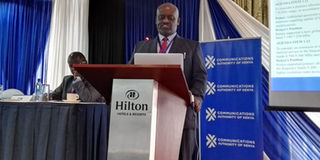Kenya granted superior radio frequencies

Mr Tom Olwero the director frequency spectrum management at the Communications Authority on February 24, 2016 at Hilton Hotel, Nairobi discussing spectrum allocation with stakeholders. PHOTO | LILLIAN OCHIENG
What you need to know:
- Further, Kenya was granted ultra-high frequency band (470MHz-694MHz) for rollout of digital TV services without the risk of an impending change in use of the spectrum.
- Already, Safaricom has begun the rollout of 4G network. The high speed 4G network has larger capacity to deliver data and facilitate high-end services such as video conferencing and gaming.
- Mobile operators have been looking forward to the 700MHZ frequency spectrum, preferred over the 2.6GHz because it covers a wider radius of between 19.2 and 28.8 kilometres. This reduces expenses for operators in terms of construction of base stations.
Kenya is among African countries set to benefit from a new framework governing the use and allocation of spectrum in the continent, to curb network interferences and ensure a fair regulatory environment.
Following the revision of radio-frequency regulations at the World Radio Communication Conference 2015 in Geneva, Switzerland, an international treaty governing the use of spectrum was released.
The Communications Authority (CA) said that an agreement to ensure harmonised standards for use of the 700 MHz frequency band was obtained at the conference.
Further, Kenya was granted ultra-high frequency band (470MHz-694MHz) for rollout of digital TV services without the risk of an impending change in use of the spectrum.
“The adaptation and utilisation of these radio frequencies will ensure that harmful interference between radio stations of different countries is avoided,” said Mr Francis Wangusi the director-general CA, “The final acts of the views adopted at the Geneva conference will come into effect by January 1, 2017.”
INTERNET ROLLOUT
The use of frequencies released after digital migration, for instance will be governed by the harmonised regional policies. This will ensure that telecom firms that get frequencies in the preferred high bands will deepen the rollout of fourth generation Internet services and fifth generation (super high speed) Internet in two years’ time.
Already, Safaricom has begun the rollout of 4G network. The high speed 4G network has larger capacity to deliver data and facilitate high-end services such as video conferencing and gaming.
Mobile operators have been looking forward to the 700MHz frequency spectrum, preferred over the 2.6GHz because it covers a wider radius of between 19.2 and 28.8 kilometres. This reduces expenses for operators in terms of construction of base stations.
Kenya currently has no clear policy that facilitates allocation of spectrum. The World Bank’s investment arm the International Finance Corporation proposed a Public Private Partnership (PPP) approach towards allocation of spectrum among telecoms.
The CA had for instance allocated Safaricom a trial frequency in the 800MHz band as part of the Sh15 billion security deal with government. The move sparked rivalry among other telecom firms Airtel Kenya and Telkom Kenya who said the deal was unfair.
The regulator is now on a mission to ensure that the high frequency bands are shared among the telecom operators.
Currently, from the freed frequencies, Kenya will be able to track flights in civil aviation, ensuring improved aircraft safety. The frequencies will also be used for enhanced maritime port communications systems.





